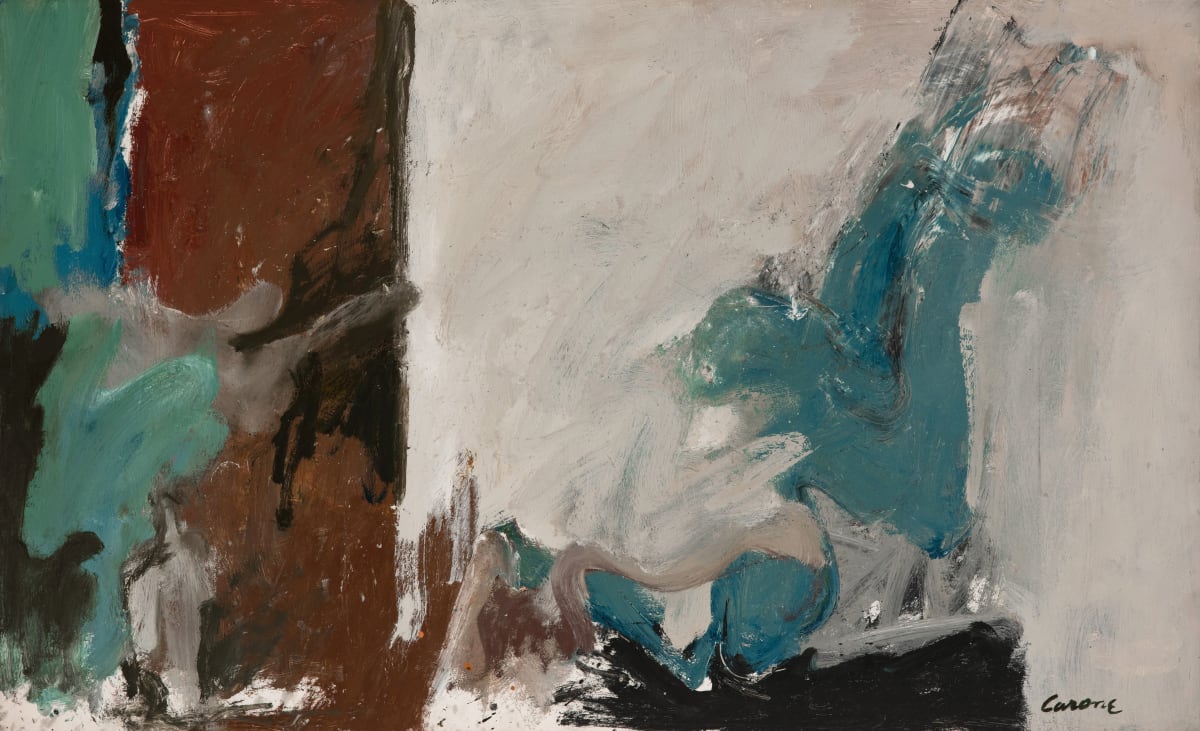
his style remained relatively the same as the decades progressed – complex compositions of shifting lines and layered brushwork of the action painters
Nicolas Carone was a pioneering Abstract Expressionist. A true mover and shaker, Carone helped shape the dynamic New York art scene of the 1950s with both his own work, as well as organizing the fledgling New York School as a curator at the influential Stable Gallery. Carone outlived most of his Abstract Expressionist colleagues, yet his style remained relatively the same as the decades progressed – complex compositions of shifting lines and layered brushwork of the action painters that enveloped the classical figural tradition he absorbed while living abroad in Italy.
Nicolas Carone was a pioneering Abstract Expressionist. A true mover and shaker, Carone helped shape the dynamic New York art scene of the 1950s with both his own work, as well as organizing the fledgling New York School as a curator at the influential Stable Gallery. Carone outlived most of his Abstract Expressionist colleagues, yet his style remained relatively the same as the decades progressed – complex compositions of shifting lines and layered brushwork of the action painters that enveloped the classical figural tradition he absorbed while living abroad in Italy.
Nicolas Carone was born in Manhattan’s Lower East Side in 1917, the oldest of seven children of Italian immigrants. When he was five, his family moved to Hoboken, New Jersey, but from a young age he commuted back to the city at night to take art classes at the Leonardo da Vinci Art School on East 10th Street. After graduating high school, Carone attended the Arts Students League and the National Academy of Design (now known as the National Academy Museum and School of Fine Art), where he studied under Leon Kroll, for whom he would later assist with a mural commission for the Worcester Memorial Auditorium in Worcester, Massachusetts.
In early 1941, Carone won the prestigious Prix de Rome for painting, but World War II made travelling to Europe impossible, so the artist received $1,500 in grant money instead. By the end of that year, Carone had enlisted in the U.S. Air Force, where he served in the First Fighter Command at Long Island’s Mitchel Field Air Force Base. His enlistment, however, did not interrupt his artistic studies and work; during his time off, Carone hitchhiked into the city where he immersed himself in its vibrant art scene, particularly that surrounding Alexander Iolas’ gallery, and during his furloughs travelled to Provincetown, Massachusetts to study at Hans Hoffman’s legendary school. Under Hoffman’s tutelage, Carone’s style changed dramatically from figurative and realistic work to increasingly abstract and gestural compositions.
Carone was discharged from the army in 1945, and spent the next two years working in his New York studio. In 1947, he took his Prix de Rome money, as well as funding from the G.I.Bill, and moved to Italy, establishing a studio in the center of Rome. He quickly became enmeshed in the city’s art scene, and befriended many of its most celebrated resident artists such as Giorgio Morandi, Gino Severini, Lucio Fontana, and most importantly the Chilean painter Roberto Matta, who became a key influence in Carone’s later work.
Carone returned to New York in 1951, and participated in the famed Ninth Street Show along with other artists like Willem de Kooning, Jackson Pollock, Robert Motherwell, and Robert Rauschenberg. His work in the show caught the attention of Eleanor Ward, with whom he helped open the Stable Gallery in Midtown Manhattan. During his tenure there, Carone directed its mission towards furthering the pioneering work instigated by the Ninth Street Show, primarily by organizing the New York Annuals (1953-1957), a series of exhibitions that added cohesion to the New York painting scene and in which he also showed his own work. In addition to his participation in the Stable annuals, Carone also appeared in group shows at the Solomon R. Guggenheim Museum in 1956, and in the 1955 and 1958 Carnegie Institute exhibitions of international painting. In 1956, Carone’s work served as the representative of American painting at the Venice Biennale, and again in 1958 at the World’s Fair in Brussels.
Starting in the late 1960s, Carone spent his summers in Italy, where he opened his own International School of Art in the mid 1980s. Carone was a dedicated teacher throughout his career, holding positions at Yale University, Columbia University, Brandeis University, Cornell University, the Cooper Union, and the New York Studio School. Carone’s International School operated primarily in summer sessions, allowing him to return to the United States in the fall to teach at these many institutions. Indeed, teaching and the administration of his school in Italy took up most of his time and left little for him to promote his own work – he showed publically only intermittently, although he continued to sell privately.
The 21st century ushered in a renewed interest in Carone’s work. He was included in many group shows, and in 2003 had a solo show at the Butler Institute of American Art in Youngstown, Ohio, and another in 2005 at the Lohin Geduld Gallery in New York City. Carone continued to work in his studios in Italy, New York City, and the Hudson Valley until his death in the Hudson Valley in 2010 at the age of 93.








